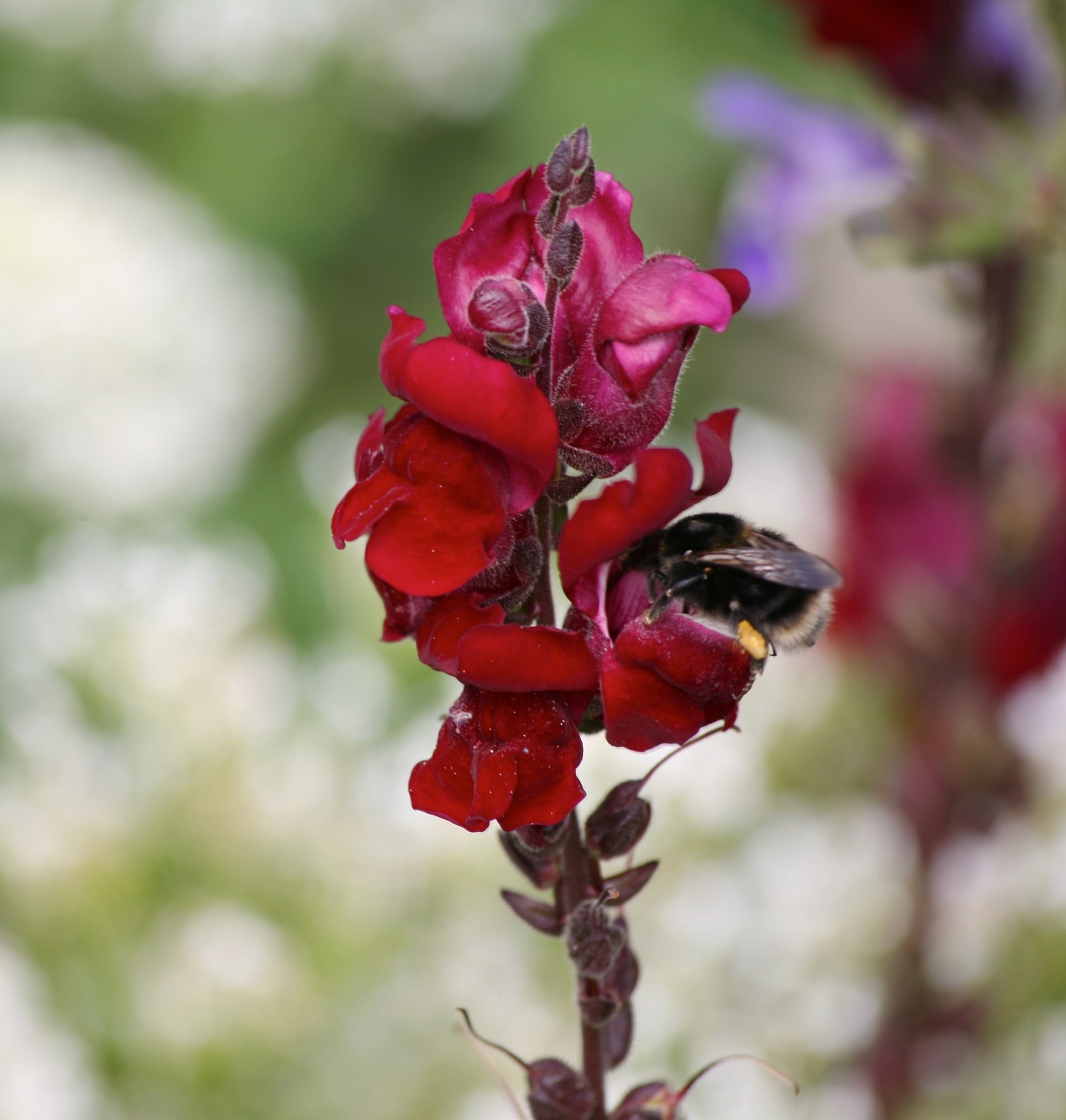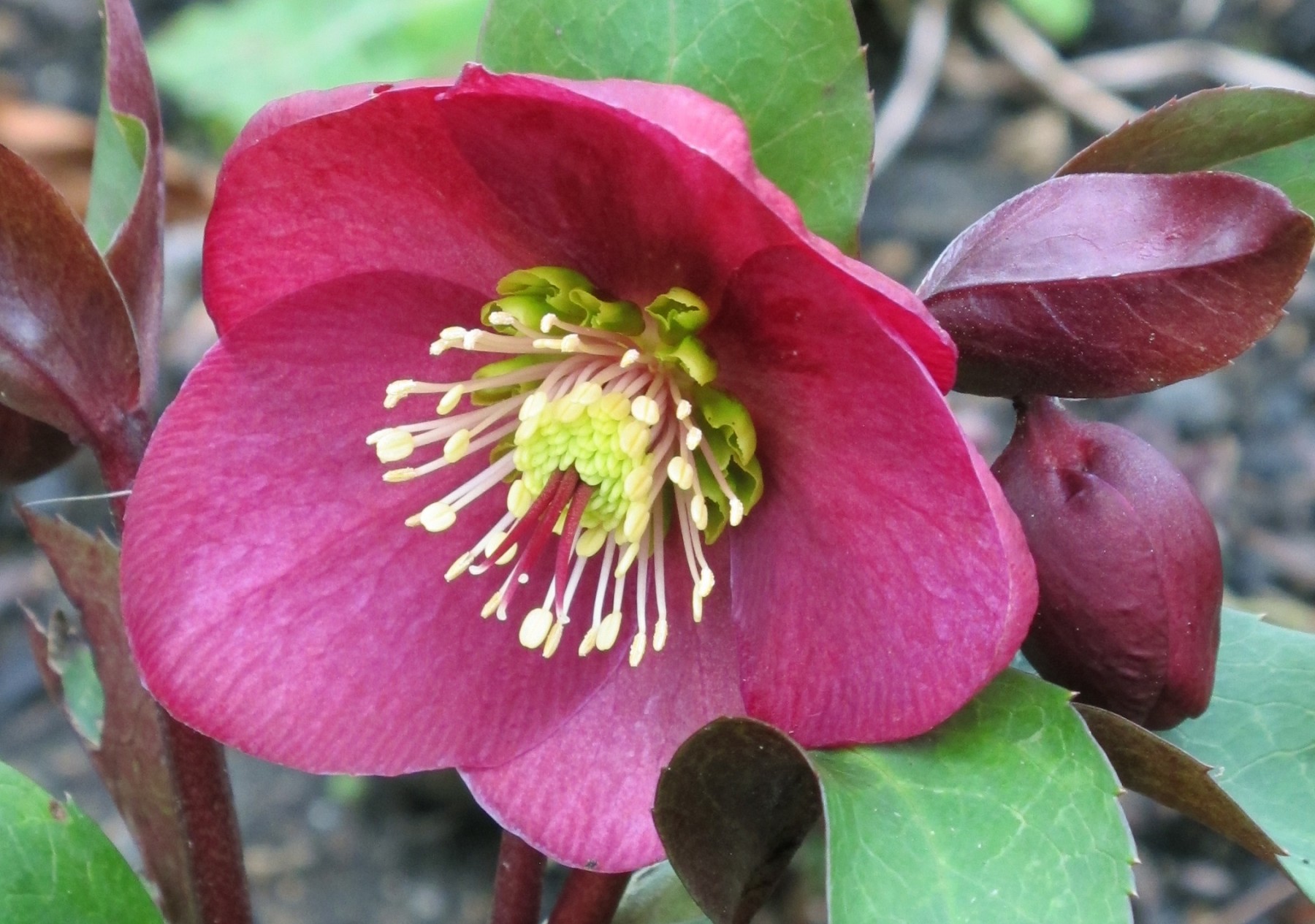
There’s no question about it. I have too many hellebores in my garden. I know this is true because the famous nurseryman, Bob Brown, once came to my garden and exclaimed in basso profundo “too many hellebores Val.” The late Christopher Lloyd, of Great Dixter, went even further and called people like me helle-bores. Fortunately I’m spirited enough not to take any notice of these two chaps, or indeed any chaps, because I love my hellebores. I’ve been collecting them for thirty years – so there!
You see their timing is immaculate, because they open their saucer-shaped flowers in early spring just as the first bumblebee queens emerge. The earliest is usually the buff-tailed bumblebee ( Bombus terrestris) and you can see this large queen bee on January afternoons, if the temperature rises above 10° C. These large queen bees come out of hibernation and need an instant nectar fix for energy, along with pollen for starting their brood. One successful queen bee could produce a colony of three to four hundred and you will often see the queens zigzagging over the ground looking for a suitable nesting site. One queen colonised an old mouse hole in our lawn, but she was ousted by a red tailed bumblebee ( Bombus lapidarius) later in the year. Mouse holes are desirable residences! Darwin had a theory that old maids with cats affected bee populations because there were fewer mouse holes.
Bumblebees are great pollinators and very different from the honeybee. They fly early because they have the ability to rev up their flight muscles in cool conditions and there are five species of bumblebee actually found inside the Arctic Circle, so these are the bees that pollinate our early crops and flowers. Honeybees, on the other hand, can only fly in warmer temperatures and they will not leave the hive unless the weather’s clement because they store their own food. They have no need to battle through poor weather.
Honeybees are very consistent because the waggle dance indicates where they have to go, so if they’re pollinating apple blossom the workers only visit apple trees. The bumblebee is a random browser and you can watch them going from flower to flower. They have a unique ability to buzz pollinate as well: they literally shake the pollen from the anthers. They’re quite large and heavy and able to access lots of flowers honeybees fail with. They can lever open snapdragons for instance. They are the main pollinators of broad beans and the set is always improved when bumblebees visit the flowers.
That’s my excuse for having so many hellebores, they’re eco-friendly, although it’s only part of the reason. I’ve been collecting them for many a year and plant breeders have made a huge difference to them in the last 25 years. They’ve produced clear colours and strong plants and most of my hellebores come under the loose term of hybrid hellebores (Helleborus x hybridus) because they’re mixtures of several species. Hybrids always have more vigour than species do.

The most famous breeder is Ashwood Nurseries owned by John Massey. John employs a large and loyal staff at the nursery near Kingswinford in the West Midlands and he began to sell hellebores in order to encourage people to come to the nursery in winter and early spring. Kevin Belcher took on the job of hybridising them and the Ashwood hellebores are now world famous. Many gardeners, including me, make a special journey to Ashwood early in the year. I have driven through snow!
I have a fair few Ashwood hybrids but I also grow the Harvington strain, developed by Hugh Nunn in the Worcestershire village of the same name. Hugh has now retired but his daughter Penny ( www.twelvenunns.co.uk ) is carrying on his work. The Harvington strain was partially developed using Helen Ballard’s hellebores, raised in the 1960s. She collected wild species, in the days when it was permitted, and crossed them to produce rounded flowers in clear colours. She named them and raised them by division, something hellebores resent, but could never produce enough to meet demand. When Hugh moved in to Harvington one of his neighbours was Helen’s daughter, Sarah. Hugh used some of Ballard’s plants in his breeding programme, but he also acquired plants from Robin White of Blackthorn Nursery in Hampshire and Elizabeth Strangman’s Washfield Nursery in Kent. Some of my plants came from this source, although sadly both nurseries are no longer. If you need to divide a hellebore, split it into two at most. Small ‘noses’ die.
One of the lesser known heroes of the hellebore world is Rodney Davey of RD Plants, surely one of the best plant puns. This Devon nursery, which I think is no longer open to the public, was co-owned by Lynda Windsor. It used to send out a slim green catalogue with a diagram of an old-fashioned telephone on the front. There were strict instructions about when to phone, although you rarely got through and couldn’t leave a message. Making an appointment to visit was almost as hard as getting into Buckingham Palace. You see Rodney was dedicated to his plants and Lynda was dedicated to Rodney. I did manage to visit twice and I acquired hellebores both times. Rodney was hybridising in a different way. He was selecting for marbled foliage and flower, not just flower. Hellebores with lovely foliage were already in existence. The most readily available was H. x ericsmithii, named after the man who made the first three-way hybrid cross between H. niger and H. sternii (H.argutifolius x H.lividus). The flowers are creamy white, but I’ve found this peters out in my garden after 3 to 4 years.
Rodney Davey injected bright coloured flowers into these marbled-leaved hellebores and the first one was named after a fabulous garden writer called Anna Pavord. She wrote about her WOW moment when she saw it on Rodney’s greenhouse bench. It was named ‘Anna’s Red’ after her. Anna wrote in The Independent that it “took Rodney 12 years to achieve his goal of raising a red-flowered hellebore with marbled leaves. First of all he had to create the mother plant, painstakingly transferring pollen from one hellebore to another in the hope that at least a few of the seedlings raised from the cross would carry the characteristics he was looking for. When finally he was satisfied with the mother he had created, he started on the next round of crosses, using the pollen from several different hellebores. For years he sowed the seeds that resulted from this second round of crosses, putting the best to the best, but in each batch of a thousand seedlings, he rarely kept more than two to grow on” Thankfully Rodney likes a challenge.

These complex hybrids are sterile, so they produce no seeds and therefore have to be micro propped. John Massey came to Rodney’s aid and introduced him to Bart Noordhuis, a Dutch propagator. In 2012 I was able to buy the very new ‘Anna’s Red’ from Ashwood’s stand at the February Show – the one that used to be held in Vincent SquareI It’s still flowering every year! That plant was a king’s ransom and I felt vindicated that it was being sold at Great Dixter! Say no more about Helle-bores!
The Rodney Davey Collection, distributed through Bransford Webbs, includes the following.
‘Charmer’ – large deep burgundy coloured flowers
‘Cheryl’s Shine’ – light pink flowers
‘Dana’s Dulcet’ – two toned pinky green flowers
‘Dorothy’s Dawn’ – delightful pink flowers
‘Glenda’s Gloss’ – white flowers with a magenta edge
‘Molly’s White’ – white flowers
‘Moondance’ – crisp white flowers
‘Penny’s Pink’ – large pink flowers
‘Pippa’s Purple’ – smokey pink flowers,
‘Reanna’s Ruby’ – deep burgundy red flowers
‘Sally’s Shell’ – soft pink flowers



